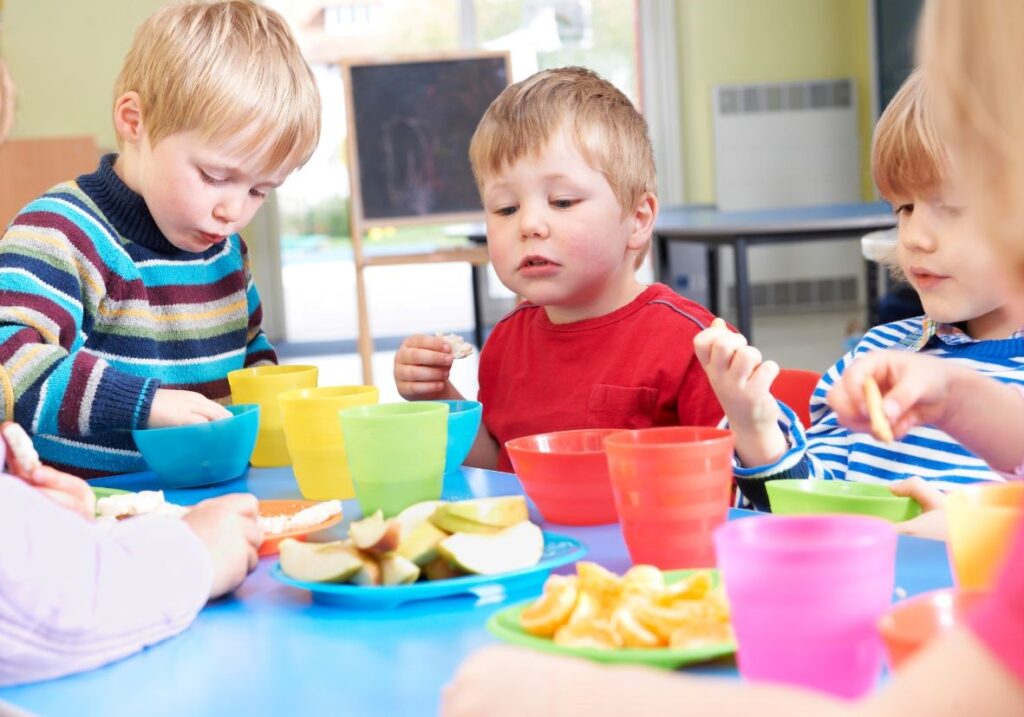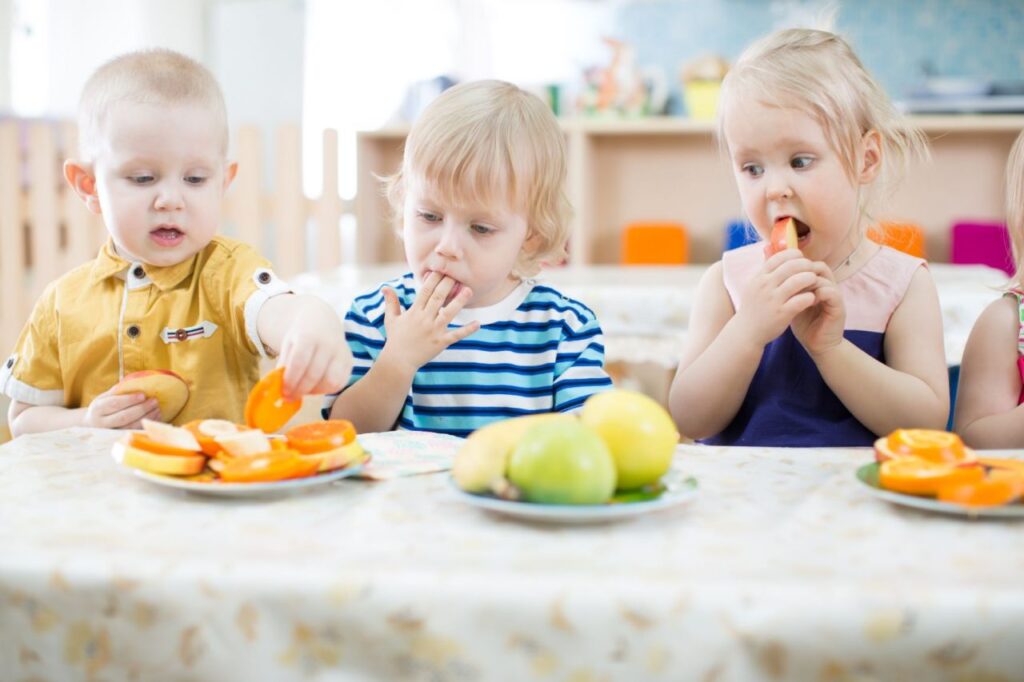This blog was written in partnership with Laura Matthews, Registered nutritionist, Food Consultant and Early Years Nutrition Expert. Laura works with nurseries to help them improve the food being offered to children.
If your little one is in nursery or about to start, you’ve probably wondered: What are they actually eating there? And more importantly, is it balanced, nutritious, and appropriate for their age?
Well, from September 2025, nurseries and early years settings in England will be expected to follow a new set of nutrition guidelines as part of the Early Years Foundation Stage (EYFS) statutory framework. These updates are a really positive step forward – and they give parents and practitioners much clearer expectations around what food and drink should look like in early years settings. Providers must take this guidance into account and should follow it unless there is good reason not to.

So let’s break it all down so you fully understand what children at nursery are supposed to be being offered.
What’s New in the 2025 Guidance?
The new guidance introduces a more structured and thoughtful approach to meals and snacks. It moves away from the old “main + pudding” model and instead encourages nurseries to offer starters, sides, and second courses – just like we might at home.
Here’s a simplified breakdown of what’s now expected:
Meal & Snack Expectations (from Table 2 of the 2025 Guidance)
| Meal / Snack | What Nurseries Should Provide |
| Breakfast | – A portion of starchy food (e.g. toast, porridge, low-sugar cereal) – A portion of fruit and/or vegetables (at least) – A dairy food or fortified plant-based alternative – Water, plain milk or unsweetened calcium fortified non-dairy alternatives to drink |
| Mid-Morning Snack | – A fruits and vegetables such as veggie sticks or fruit slices at some snack times – Provide a starchy food as part of at least one snack each day e.g. unsalted crackers or toast fingers – Water or milk to drink -No crisps, biscuits, cakes, or sugary snacks. No dried fruit as snacks. |
| Lunch | – A main course with: • Starchy food (e.g. pasta, rice, potatoes) • Protein (e.g. lentils, meat, fish, eggs) • At least one portion of vegetables and/or fruits – A starter: e.g. soup, salad, or veg sticks OR – A side dish to increase veg variety or texture OR – A second course (optional): e.g. plain yogurt and fruit – avoid sweetened yogurt and dairy or non dairy alternatives & choose plain options – Water to drink |
| Afternoon Snack | – Similar to morning snack: fruit or veg, and a starchy food 1x a day as a snack – Water or milk to drink |
| Tea (Light Meal) | – A smaller, balanced meal with: • Starchy food • Protein • At least one portion of vegetables or fruit – A starter or side may be included OR – A second course – Water to drink |
Some of the Key Principles in the New Nursery Food Guidance
- Water must be freely available throughout the day.
- No added salt or sugar in meals or at the table.
- Processed meats (like sausages, ham, bacon) should be limited to once per week.
- Fried starchy foods should be served no more than once per week.
- Wholegrains should be included regularly, but not exclusively (to avoid fibre overload).
- Plant-based alternatives must be fortified with calcium (and ideally vitamin B12 and iodine too, in my opinion) if used in place of dairy.
What’s Changed from the 2017 Guidance?
Puddings
I know from speaking to parents that one of the things people were frustrated about were the puddings often on offer at nurseries. However according to the updated guidance from the Department for Education, puddings are not a required part of meals anymore and there is more of an emphasis on the use of starters, sides, and second courses – rather than simply offering a main and a pudding. There are examples of these for nurseries to follow and many of the options suggested aren’t sweet e.g. beetroot dip with pitta fingers, or cheese and sliced strawberry. There is much less suggestion about the need for a “sweet pudding” with custard and sponges in the example meal ideas in the new guidance.
This shift moves away from the traditional “main meal + dessert” model and instead promotes a more balanced, flexible way of serving food that reflects how we might eat at home or in a family-style setting. And also meaning that little ones don’t need to be offered a sweet pudding after each main meal, which was often interpreted by nurseries based on the older guidance.

Here’s how it might work:
- Starters might include a small portion of soup, salad, or vegetable sticks – something light and nutritious to begin the meal.
- Sides are encouraged to ensure children are exposed to a variety of different foods and top up their food groups. For example, a main dish might be served with steamed broccoli and a some sweet potato wedges.
- Second courses are not synonymous with puddings. Instead, they can include fruit, plain yogurt, or a small portion of a fruit-based dish. The emphasis is on fruit as the default option, and puddings – if offered—should be occasional, fruit-based, and not overly sweet to fit with the guideline that nurseries should “avoid foods high in saturated fat, salt and/or sugars like cakes, sweet and savoury pastries, biscuits, crisps, chocolate and other confectionary”.
Ideally these will:
- Encourage more variety and balance across the day and within the meals.
- Offer extra ways to get kids to eat different parts of a meal, even if they don’t accept the main.
- Reduce reliance on sweet foods as a “reward” or expected end to a meal.
- Support children in learning to enjoy a wider range of flavours and textures.
It’s a subtle but important shift that aligns with the broader goals of the guidance: to support healthy eating habits, reduce sugar and salt intake, and create positive mealtime experiences all round.
The new guidance actually supports better approaches for picky eaters too. The shift to starters, sides, and/or second courses means children have multiple opportunities to find something they’ll accept at each meal occasion.
The previous guidance (from the Example Menus for Early Years Settings) was helpful, but it wasn’t mandatory—and it didn’t always feel clear or consistent. Here’s how the new guidance compares:
| Category | 2017 Guidance | 2025 Guidance |
| Status | Advisory only | Expected to be followed as part of EYFS statutory framework |
| Meal Structure | Clear expectations for each meal/snack | Clear expectations for each meal/snack, with optional starters, sides, and second courses |
| Snacks | Guidelines on food groups, but less specific limitations | Should be nutritious: fruit, veg, or starchy foods; no crisps, biscuits, dried fruits, sweetened dairy or high sugar cakes |
| Puddings | Regular part of the old menus with sponges and custard examples | Not required; can now be a starter, side or a second course instead and shouldn’t be overly sweet. |
| Processed Meats | Limited to once per week | Limited to once per week |
| Fried Foods | Limit starchy fried foods to once a week at lunch | No more than once per week |
| Salt & Sugar | Advised to limit | Specifics given – avoid foods high in saturated fat, salt and sugar. Use unsweetened, plain dairy and alternatives. Avoid cereals labelled as “high” |
| Wholegrains | Recommended a variety of wholegrain and white starchy | Should be included regularly, but not exclusively |
| Water Access | Access and milk and water recommended | Must be freely available all day. Milk and water only drinks recommended |
| Plant-Based Alternatives | Mentioned | Must be fortified with calcium if replacing dairy |
Why This Matters:
As a nutritionist and a mum, I know how important it is to feel confident about what our little ones are eating – especially when we’re not there to see it. These new guidelines are a really positive step forward. They give nurseries a clear framework to follow and help ensure that all children are getting the nutritious, balanced meals they need to grow, learn, and thrive.
And for parents? It’s a great opportunity to open up conversations with your childcare provider. Ask about their menus, how they’re adapting to the new guidance, and how they support children’s eating habits throughout the day.
How can parents be sure that the 2025 guidance is being adhered to?
What to look for:
- Menus displayed publicly – current weekly menus should be visible to parents
- Meal structure changes – look for starters/sides instead of just “main + pudding”
- Snack descriptions – should list fruit/veg and starchy foods, not biscuits/cakes
- Drink options – only water and milk mentioned, no squash/juice
- Second courses – described as “fruit and yoghurt” not “chocolate sponge and custard”
- Weekly variety – menus should show processed meat and fried food limited to once weekly
A few red flags to look out for:
- Still offering traditional puddings – daily chocolate cake, jam tart, custard and sponge
- Processed meat more than weekly – sausages, ham, bacon appearing multiple times
- Fried foods frequently – chips, fried chicken, fried fish more than once per week
- Sugary snacks – biscuits, cakes, dried fruit, sweetened yoghurts listed as snacks
- Limited vegetable variety – same 2-3 vegetables appearing repeatedly
- No mention of starters/sides – still just showing “main + pudding” format
- Staff seem unaware of the new guidelines when asked
If you’re worried that your child’s nursery isn’t following the 2025 nursery food guidance, it’s important to speak up. From September 2025, nurseries are expected to follow the updated Early Years Foundation Stage (EYFS) nutrition standards unless there’s a valid reason not to. As we’ve seen, these guidelines ensure that meals, snacks, and drinks provided are healthy, balanced, and developmentally appropriate. If you’re concerned you could start by having a respectful conversation with the nursery manager, ask how they’re implementing the new guidance and whether they’ve updated their food policies. If they don’t know about the guidance give them the details and check in. Never be afraid to open up communications. If concerns remain, you can contact your local authority or Ofsted to raise the issue and seek further support.

Final Thoughts
This update is a win for children, families, and early years staff alike. It’s about raising the bar for food in nurseries and making sure every child has access to meals that support their health and development.
If you’re a parent, carer, or practitioner and want to learn more, you can read the full 2025 EYFS Nutrition Guidance and compare it with the 2017 Example Menus.
And as always, if you’re feeling unsure about what your child is eating at nursery – ask! You deserve to feel confident and reassured.
I have another blog on New Nursery Nutrition Guidelines which goes into detail about the 2025 updated nursery food guidance, why it was needed and what nurseries need to know. I also have a blog on What Does Good Nursery Food Look Like.